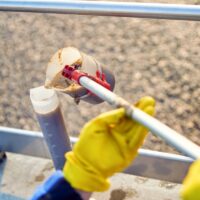NJDEP New Guidance for Contaminants of Emerging Concern

On August 5, 2021, the New Jersey Department of Environmental Protection (NJDEP) issued new guidance concerning contaminants of emerging concern (CEC). The guidance pertains to contaminants that have recently been shown to occur in the environment and have been identified as a potential environmental or public health risk, including per- and polyfluoroalkyl substances (PFAS). The new guidance addresses a variety of factors important to developers and property owners, including contamination standards and remediation timelines. See below for an overview of several of the important elements of the new CEC guidance. Call a licensed underground storage tank (UST) remediation and removal professional if you need assistance with a damaged or contaminated UST.
NJDEP FAQ for Regulated Parties
NJDEP’s new guidance includes, among other things, a list of Frequently Asked Questions (FAQ) that advises parties covered by the regulations on a variety of obligations pertaining to CECs. The FAQ covers the regulated community’s duty with regard to:
- Reporting obligations
- Remediation obligations
- Proper methodology for analyzing for CECs
- How to determine when evaluations for CECs should be conducted, including after finalizing remediation
- Requirements for public notification
- The proper procedures to employ when evaluating whether CEC contamination arose from off-site sources
Guidance for Remediation: Highlights
NJDEP takes pains to specify that remediation obligations for regulated parties concerning CECs “are no different than their obligations for any other contaminant, including but not limited to, notification to the Department via the NJDEP Hotline for all discharges and, as necessary, remediation of any such discharges under N.J.A.C. 7:26C-1.7.”
NJDEP notes the same regarding licensed site remediation professionals (LSRPs), stating that LSRP responsibilities concerning CECs include “satisfying all notification requirements and ensuring that the remediation of any such discharges is protective of public health and safety and the environment.”
However, because technologies for identifying and analyzing these CECs have evolved in recent years, the guidance does explore what to do when CECs are identified at a site already undergoing remediation. The party undertaking the remediation can either merge the CEC incident into the existing case and complete the remediation under the existing timeframes, or they can create a new case with a new set of remediation timeframes specifically for the CEC incident. That means that parties already undergoing remediation who suddenly discover CEC contamination, which might require significant additional remediation time and effort, are not bound by the original timeframes with regard to handling the CECs. Of course, if the timeframe for the original remediation has already passed (and no extensions are possible), then a new case must be created.
The guidance notes that merging into an existing remediation case should only be utilized if the LSRP believes that remediation can be completed within the current timeframe. If they would need an extension specifically to deal with the CECs, then they should default to creating a new case on the CEC contamination. Once a new case is established, it cannot be merged into another, existing remediation case.
The Savvy Remediation Pros at Lutz Are Here to Help With Your Underground Storage Tank Issues
If you discover a UST at your construction worksite or if you have to respond to a UST spill on your property, you need experienced help from knowledgeable advisors with years of underground storage tank experience. For qualified and reasonable assistance dealing with a UST on your property, call Herbert Lutz & Company in Florida at 954-971-5222, or in New Jersey at 908-862-8888.
